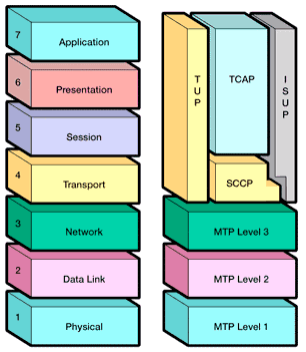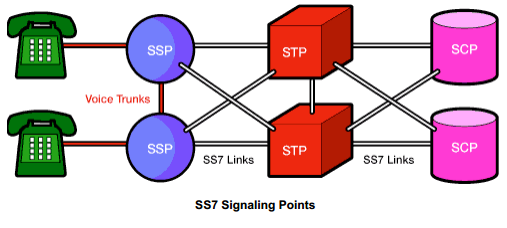SS7 stand for the Signalling System 7 and a signalling protocol to do out of band signalling to support call setup, tear-down, billing, routing and information exchange for PSTN (public switch telephone network). However over the period of time SS7 signalling was used in 2G and 3G network also for the signalling exchange.
SS7 protocol suite has 4 levels (layers) as compere to OSI 7 Layer Model. The levels 1 to 3 constitute the Message Transfer Part (MTP) and level 4 is the User Part (Transport Layer in OSI).

MTP1 = Message Transfer Part 1
MTP2 = Message Transfer Part 2
MTP3 = Message Transfer Part 3
SCCP = Signaling Connection Control Part
TCAP = Transaction Capabilities Application Part
MAP = Mobile Application Part
INAP = Intelligent Network Application Part
ISUP = ISDN User Part
1.) Message Transfer Part (MTP Level 1) Physical
Provides an interface to the actual physical channel over which communication takes place CCITT recommends 64Kbps transmission whereas ANSI recommends 56 Kbps
2.) MTP Level 2 (Data Link)
Ensures accurate end-to-end transmission of a message across a signaling link Variable Length Packet Messages are defined here Implements flow control, message sequence validation, error checking and message retransmission Monitor links and reports their status Test links before allowing their use
3.) MTP Level 3 (Network)
Message routing between signaling points in the SS7 network Signaling network management that provides traffic, links and routing management, as well as congestion (flow) control Re-routes traffic away from failed links and signaling points, controls traffic when congestion occurs
4.) Signaling Connection Control Part (SCCP)
· Provides connectionless and connection-oriented network services
· Provides global title translation (GTT) capabilities above MTP level 3; translates numbers to DPCs and subsystem numbers
· Provides more detailed addressing information than MTPs
· Used as transport layer for TCAP (Transaction capabilities applications part) based services
5.) Transaction Capabilities Applications Part (TCAP)
· Exchange of non-circuit related data between applications across the SS#7 network
· Queries and responses sent between Signaling Switching Point (SSPs) and Signaling Control Point (SCPs)
· Sends and receives database information i.e. Credit card validation & Routing information(TooL free call)

6.) Telephone User Part (TUP)
Basic call setup and tear down (In many countries, ISUP has replaced TUP for call management)
7.) ISDN User Part (ISUP)
Necessary messaging for setup and tear down of all circuits (voice and digital) Messages are sent from a switch, to the switch where the next circuit connection is required Call circuits are identified using circuit identification code (CIC)
